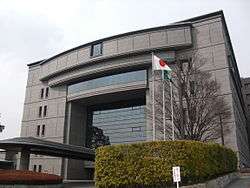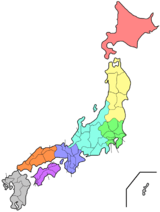Mie Prefectural Assembly
The Mie Prefectural Assembly (三重県議会, Mie-kengikai) is the prefectural parliament of Mie.
Mie Prefectural Assembly 三重県議会 Mie Kengikai | |
|---|---|
 | |
| Type | |
| Type | |
| History | |
| Founded | 1878 (first elected and convened in 1879)[1] |
| Leadership | |
President (gichō) | Norikazu Yamamoto, Liberal Democratic Party |
Vice President (fuku-gichō) | Hiroyuki Funahashi, Democratic Party (Japan, 2016) |
| Seats | 51 assembly members |
| Elections | |
| Single non-transferable vote | |
Last election | 2011 |
| Meeting place | |
 | |
| Website | |
| http://www.pref.mie.lg.jp/KENGIKAI/ | |
Its 51 members are elected every four years in 17 districts by single non-transferable vote (SNTV). 15 electoral districts are multi-member districts, two are single-member district where SNTV becomes equivalent to First-past-the-post voting.
The assembly is responsible for enacting and amending prefectural ordinances, approving the budget and voting on important administrative appointments made by the governor including the vice-governors.
Current composition
The last elections were held in the unified local elections in April 2011, at the same time when centre-right (LDP, Kōmeitō, YP) supported Eikei Suzuki narrowly beat DPJ-supported Naohisa Matsuda in the Mie gubernatorial election. In the assembly election, the Liberal Democratic Party remained strongest party, but the Democratic-Social Democratic group Shinsei Mie ("Renewal Mie") emerged as strongest force. The Japanese Communist Party lost all its seats in 2011.
As of April 30, 2011, the assembly was composed as follows:[2]
| Composition of the Mie Prefectural Assembly | |
|---|---|
| Parliamentary group | Seats |
| Shinsei Mie ("Renewal Mie" of Democrats, Social Democrats and independents) | 24 |
| Jimin Mirai ("LibDem Future" of Liberal Democrats and independents) | 21 |
| Yōzan (a group of conservative independents – according to a member, the group name is derived from Uesugi Yōzan[3]) | 3 |
| Kōmeitō | 2 |
| Minna no Tō (Your Party) | 1 |
| Total (including vacant seats) | 51 |
Electoral districts
As in all prefectures, most electoral districts correspond to current cities and former counties (while the counties were abolished as administrative unit in 1921, cities and counties had initially by definition served as electoral districts for prefectural assemblies in the Empire).
| Electoral districts[4][5] | ||
|---|---|---|
| District | Municipalities | Magnitude |
| Tsu City | Tsu City | 7 |
| Yokkaichi City | Yokkaichi City | 7 |
| Ise City | Ise City | 4 |
| Matsusaka City | Matsusaka City | 4 |
| Kuwana City/Kuwana County | Kuwana City Kisosaki Town |
4 |
| Suzuka City | Suzuka City | 4 |
| Nabari City | Nabari City | 2 |
| Owase City/Kita-Muro (North Muro) County | Owase City Kihoku Town |
2 |
| Kameyama City | Kameyama City | 1 |
| Toba City | Toba City | 1 |
| Kumano City/Minami-Muro (South Muro) County | Kumano City Mihama Town Kihō Town |
2 |
| Inabe City/Inabe County | Inabe City Tōin Town |
2 |
| Shima City | Shima City | 2 |
| Iga City | Iga City | 3 |
| Mie County | Komono Town Asahi Town Kawagoe Town |
2 |
| Taki County | Taki Town Meiwa Town Ōdai Town |
2 |
| Watarai County | Tamaki Town Watarai Town Taiki Town Minamiise Town |
2 |
References
- Mie Prefectural Assembly: 県議会の沿革 > 議会年表
- Mie Prefectural Assembly: Parliamentary groups, Members by parliamentary group (in Japanese)
- Official website of assembly member Yutaka Higashi, May 2, 2011: 会派の名前は、鷹山(ようざん)に決まりました。
- Mie Prefectural Assembly: Members by district Archived 2011-03-25 at the Wayback Machine
- Mie electoral commission: Prefectural electoral districts
External links
- Mie Prefectural Assembly (in Japanese)
- Mie Prefectural Board of Elections (in Japanese)
